Management Report: Analyzing the Fifth Discipline and Merck Case Study
VerifiedAdded on 2020/05/01
|7
|1474
|45
Report
AI Summary
This report delves into Peter Senge's Fifth Discipline, exploring its five core themes: systems thinking, personal mastery, mental models, building a shared vision, and team learning. It examines how these disciplines are interconnected and contribute to the development of a learning organization. The report provides definitions and explanations of each discipline, emphasizing their significance in fostering organizational learning and improving performance. Furthermore, the report includes a case study of Merck Company, analyzing its challenges and successes as a pharmaceutical company, and discussing how the principles of the Fifth Discipline could be applied to enhance its learning and address its issues. The analysis covers the importance of each discipline in establishing a learning organization, and suggests ways for Merck to improve its learning processes through leadership and employee development.
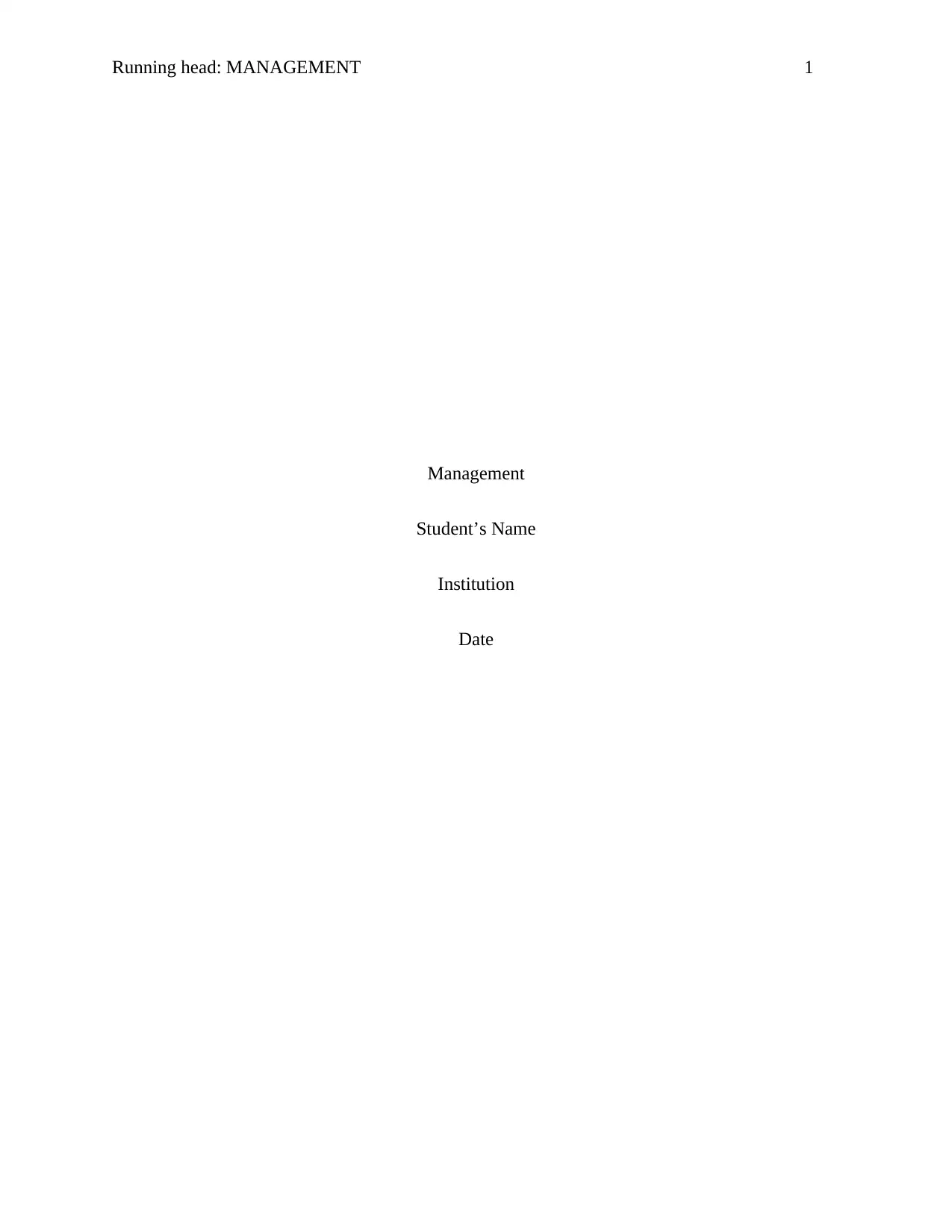
Running head: MANAGEMENT 1
Management
Student’s Name
Institution
Date
Management
Student’s Name
Institution
Date
Paraphrase This Document
Need a fresh take? Get an instant paraphrase of this document with our AI Paraphraser
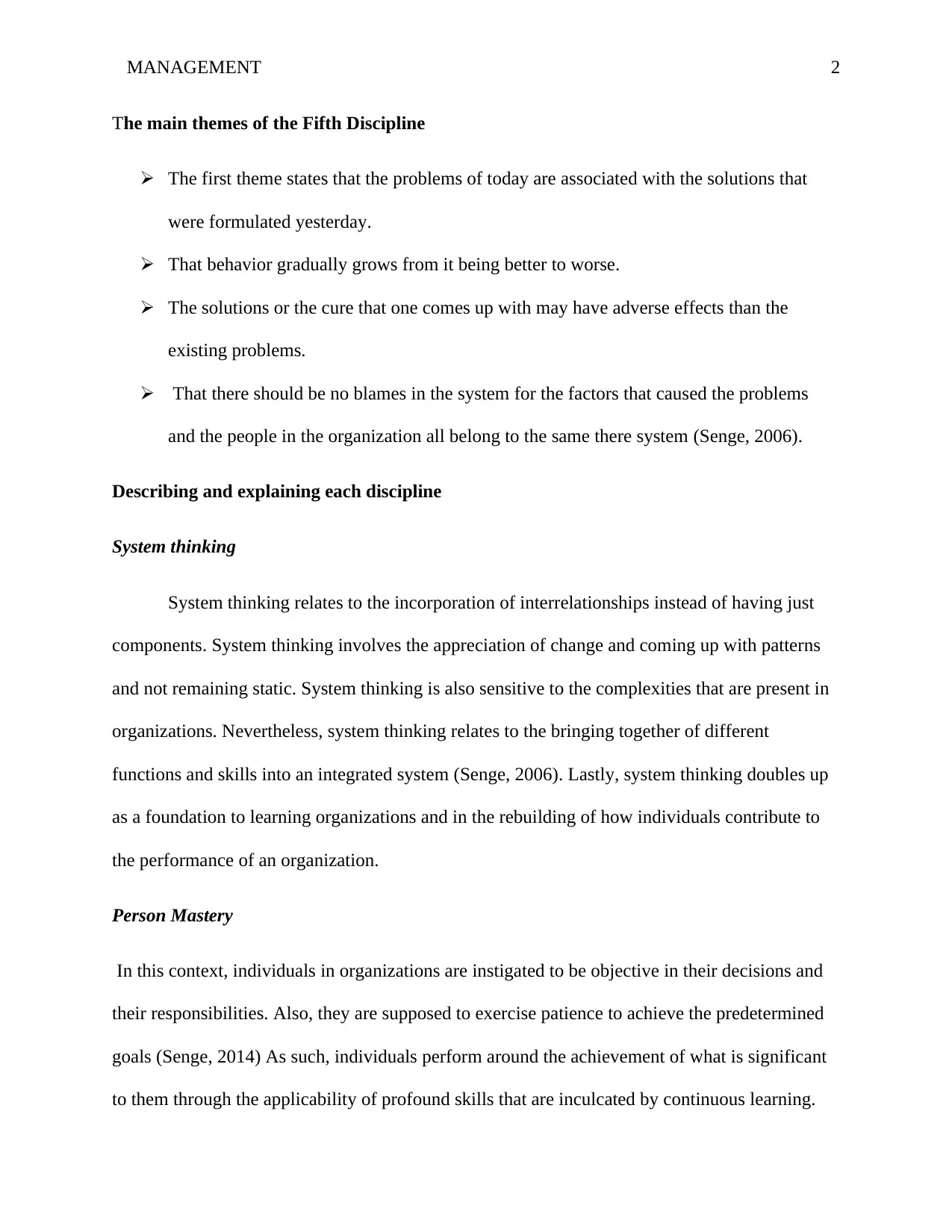
MANAGEMENT 2
The main themes of the Fifth Discipline
The first theme states that the problems of today are associated with the solutions that
were formulated yesterday.
That behavior gradually grows from it being better to worse.
The solutions or the cure that one comes up with may have adverse effects than the
existing problems.
That there should be no blames in the system for the factors that caused the problems
and the people in the organization all belong to the same there system (Senge, 2006).
Describing and explaining each discipline
System thinking
System thinking relates to the incorporation of interrelationships instead of having just
components. System thinking involves the appreciation of change and coming up with patterns
and not remaining static. System thinking is also sensitive to the complexities that are present in
organizations. Nevertheless, system thinking relates to the bringing together of different
functions and skills into an integrated system (Senge, 2006). Lastly, system thinking doubles up
as a foundation to learning organizations and in the rebuilding of how individuals contribute to
the performance of an organization.
Person Mastery
In this context, individuals in organizations are instigated to be objective in their decisions and
their responsibilities. Also, they are supposed to exercise patience to achieve the predetermined
goals (Senge, 2014) As such, individuals perform around the achievement of what is significant
to them through the applicability of profound skills that are inculcated by continuous learning.
The main themes of the Fifth Discipline
The first theme states that the problems of today are associated with the solutions that
were formulated yesterday.
That behavior gradually grows from it being better to worse.
The solutions or the cure that one comes up with may have adverse effects than the
existing problems.
That there should be no blames in the system for the factors that caused the problems
and the people in the organization all belong to the same there system (Senge, 2006).
Describing and explaining each discipline
System thinking
System thinking relates to the incorporation of interrelationships instead of having just
components. System thinking involves the appreciation of change and coming up with patterns
and not remaining static. System thinking is also sensitive to the complexities that are present in
organizations. Nevertheless, system thinking relates to the bringing together of different
functions and skills into an integrated system (Senge, 2006). Lastly, system thinking doubles up
as a foundation to learning organizations and in the rebuilding of how individuals contribute to
the performance of an organization.
Person Mastery
In this context, individuals in organizations are instigated to be objective in their decisions and
their responsibilities. Also, they are supposed to exercise patience to achieve the predetermined
goals (Senge, 2014) As such, individuals perform around the achievement of what is significant
to them through the applicability of profound skills that are inculcated by continuous learning.
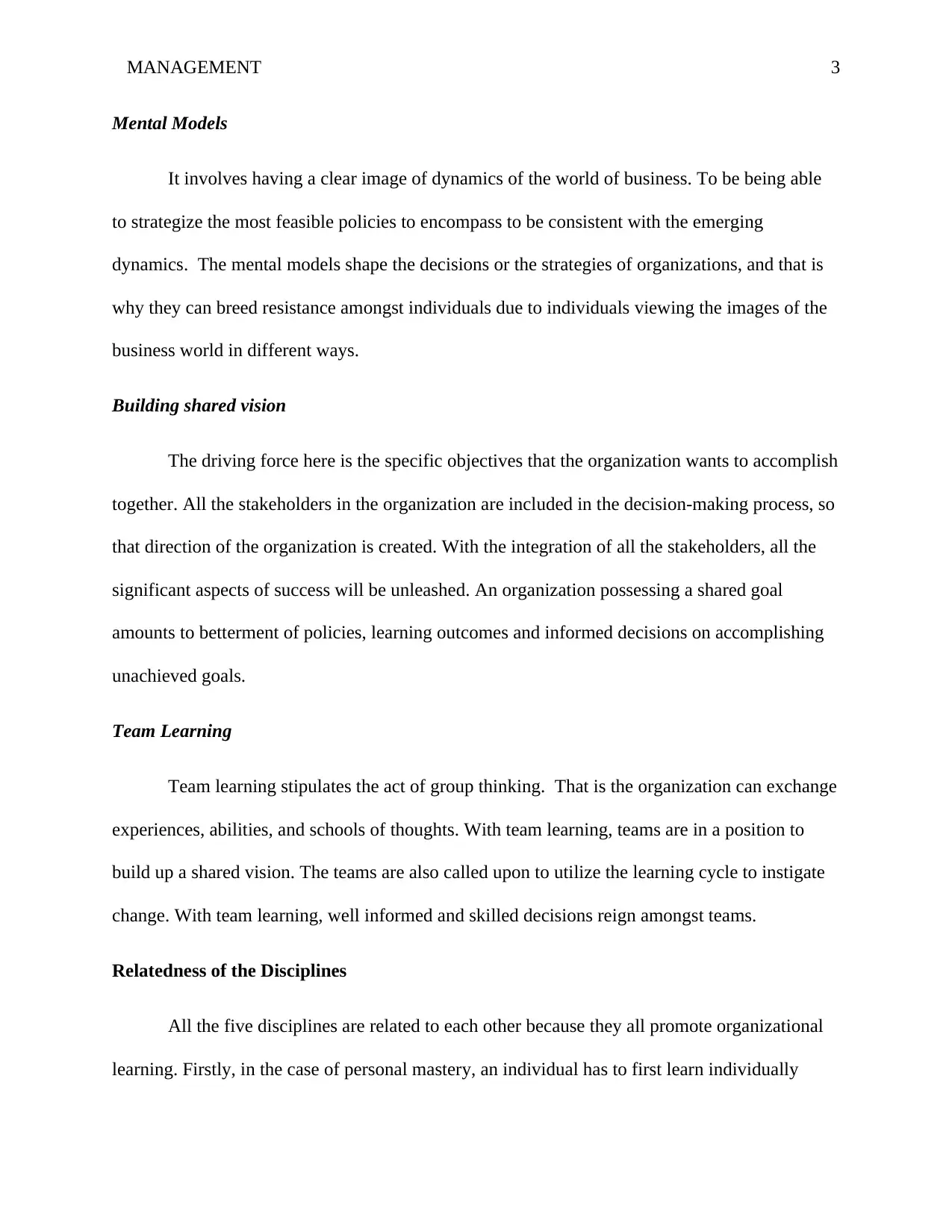
MANAGEMENT 3
Mental Models
It involves having a clear image of dynamics of the world of business. To be being able
to strategize the most feasible policies to encompass to be consistent with the emerging
dynamics. The mental models shape the decisions or the strategies of organizations, and that is
why they can breed resistance amongst individuals due to individuals viewing the images of the
business world in different ways.
Building shared vision
The driving force here is the specific objectives that the organization wants to accomplish
together. All the stakeholders in the organization are included in the decision-making process, so
that direction of the organization is created. With the integration of all the stakeholders, all the
significant aspects of success will be unleashed. An organization possessing a shared goal
amounts to betterment of policies, learning outcomes and informed decisions on accomplishing
unachieved goals.
Team Learning
Team learning stipulates the act of group thinking. That is the organization can exchange
experiences, abilities, and schools of thoughts. With team learning, teams are in a position to
build up a shared vision. The teams are also called upon to utilize the learning cycle to instigate
change. With team learning, well informed and skilled decisions reign amongst teams.
Relatedness of the Disciplines
All the five disciplines are related to each other because they all promote organizational
learning. Firstly, in the case of personal mastery, an individual has to first learn individually
Mental Models
It involves having a clear image of dynamics of the world of business. To be being able
to strategize the most feasible policies to encompass to be consistent with the emerging
dynamics. The mental models shape the decisions or the strategies of organizations, and that is
why they can breed resistance amongst individuals due to individuals viewing the images of the
business world in different ways.
Building shared vision
The driving force here is the specific objectives that the organization wants to accomplish
together. All the stakeholders in the organization are included in the decision-making process, so
that direction of the organization is created. With the integration of all the stakeholders, all the
significant aspects of success will be unleashed. An organization possessing a shared goal
amounts to betterment of policies, learning outcomes and informed decisions on accomplishing
unachieved goals.
Team Learning
Team learning stipulates the act of group thinking. That is the organization can exchange
experiences, abilities, and schools of thoughts. With team learning, teams are in a position to
build up a shared vision. The teams are also called upon to utilize the learning cycle to instigate
change. With team learning, well informed and skilled decisions reign amongst teams.
Relatedness of the Disciplines
All the five disciplines are related to each other because they all promote organizational
learning. Firstly, in the case of personal mastery, an individual has to first learn individually
⊘ This is a preview!⊘
Do you want full access?
Subscribe today to unlock all pages.

Trusted by 1+ million students worldwide
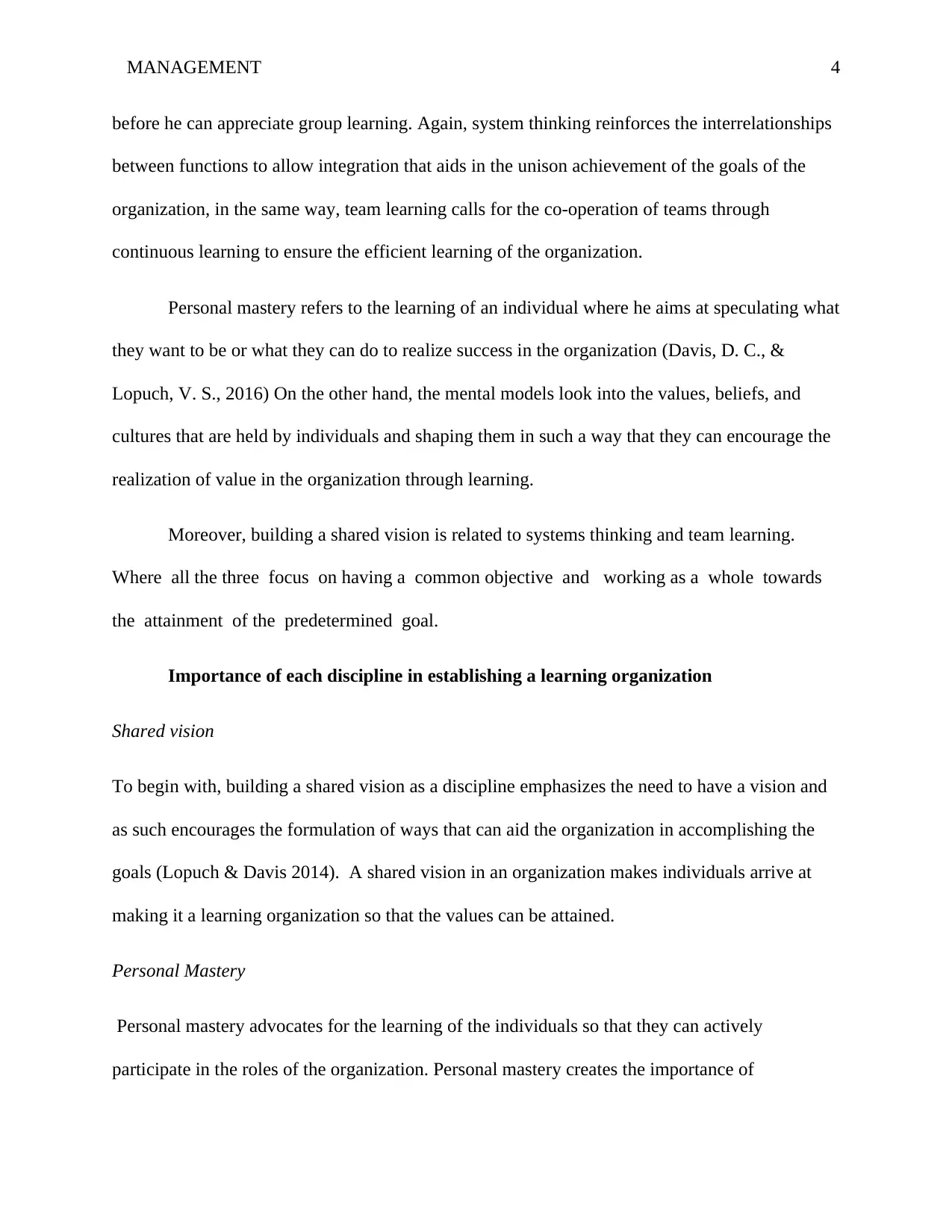
MANAGEMENT 4
before he can appreciate group learning. Again, system thinking reinforces the interrelationships
between functions to allow integration that aids in the unison achievement of the goals of the
organization, in the same way, team learning calls for the co-operation of teams through
continuous learning to ensure the efficient learning of the organization.
Personal mastery refers to the learning of an individual where he aims at speculating what
they want to be or what they can do to realize success in the organization (Davis, D. C., &
Lopuch, V. S., 2016) On the other hand, the mental models look into the values, beliefs, and
cultures that are held by individuals and shaping them in such a way that they can encourage the
realization of value in the organization through learning.
Moreover, building a shared vision is related to systems thinking and team learning.
Where all the three focus on having a common objective and working as a whole towards
the attainment of the predetermined goal.
Importance of each discipline in establishing a learning organization
Shared vision
To begin with, building a shared vision as a discipline emphasizes the need to have a vision and
as such encourages the formulation of ways that can aid the organization in accomplishing the
goals (Lopuch & Davis 2014). A shared vision in an organization makes individuals arrive at
making it a learning organization so that the values can be attained.
Personal Mastery
Personal mastery advocates for the learning of the individuals so that they can actively
participate in the roles of the organization. Personal mastery creates the importance of
before he can appreciate group learning. Again, system thinking reinforces the interrelationships
between functions to allow integration that aids in the unison achievement of the goals of the
organization, in the same way, team learning calls for the co-operation of teams through
continuous learning to ensure the efficient learning of the organization.
Personal mastery refers to the learning of an individual where he aims at speculating what
they want to be or what they can do to realize success in the organization (Davis, D. C., &
Lopuch, V. S., 2016) On the other hand, the mental models look into the values, beliefs, and
cultures that are held by individuals and shaping them in such a way that they can encourage the
realization of value in the organization through learning.
Moreover, building a shared vision is related to systems thinking and team learning.
Where all the three focus on having a common objective and working as a whole towards
the attainment of the predetermined goal.
Importance of each discipline in establishing a learning organization
Shared vision
To begin with, building a shared vision as a discipline emphasizes the need to have a vision and
as such encourages the formulation of ways that can aid the organization in accomplishing the
goals (Lopuch & Davis 2014). A shared vision in an organization makes individuals arrive at
making it a learning organization so that the values can be attained.
Personal Mastery
Personal mastery advocates for the learning of the individuals so that they can actively
participate in the roles of the organization. Personal mastery creates the importance of
Paraphrase This Document
Need a fresh take? Get an instant paraphrase of this document with our AI Paraphraser
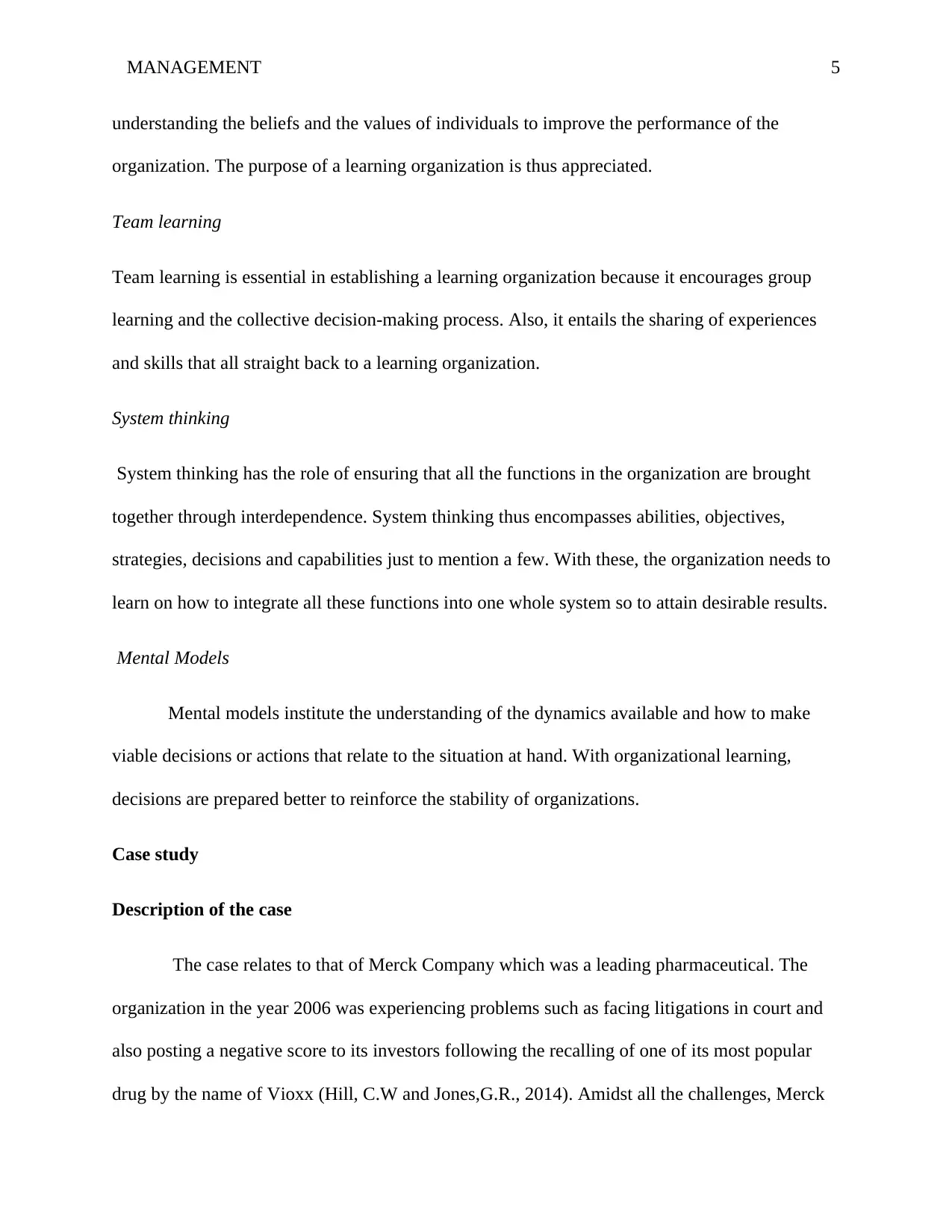
MANAGEMENT 5
understanding the beliefs and the values of individuals to improve the performance of the
organization. The purpose of a learning organization is thus appreciated.
Team learning
Team learning is essential in establishing a learning organization because it encourages group
learning and the collective decision-making process. Also, it entails the sharing of experiences
and skills that all straight back to a learning organization.
System thinking
System thinking has the role of ensuring that all the functions in the organization are brought
together through interdependence. System thinking thus encompasses abilities, objectives,
strategies, decisions and capabilities just to mention a few. With these, the organization needs to
learn on how to integrate all these functions into one whole system so to attain desirable results.
Mental Models
Mental models institute the understanding of the dynamics available and how to make
viable decisions or actions that relate to the situation at hand. With organizational learning,
decisions are prepared better to reinforce the stability of organizations.
Case study
Description of the case
The case relates to that of Merck Company which was a leading pharmaceutical. The
organization in the year 2006 was experiencing problems such as facing litigations in court and
also posting a negative score to its investors following the recalling of one of its most popular
drug by the name of Vioxx (Hill, C.W and Jones,G.R., 2014). Amidst all the challenges, Merck
understanding the beliefs and the values of individuals to improve the performance of the
organization. The purpose of a learning organization is thus appreciated.
Team learning
Team learning is essential in establishing a learning organization because it encourages group
learning and the collective decision-making process. Also, it entails the sharing of experiences
and skills that all straight back to a learning organization.
System thinking
System thinking has the role of ensuring that all the functions in the organization are brought
together through interdependence. System thinking thus encompasses abilities, objectives,
strategies, decisions and capabilities just to mention a few. With these, the organization needs to
learn on how to integrate all these functions into one whole system so to attain desirable results.
Mental Models
Mental models institute the understanding of the dynamics available and how to make
viable decisions or actions that relate to the situation at hand. With organizational learning,
decisions are prepared better to reinforce the stability of organizations.
Case study
Description of the case
The case relates to that of Merck Company which was a leading pharmaceutical. The
organization in the year 2006 was experiencing problems such as facing litigations in court and
also posting a negative score to its investors following the recalling of one of its most popular
drug by the name of Vioxx (Hill, C.W and Jones,G.R., 2014). Amidst all the challenges, Merck
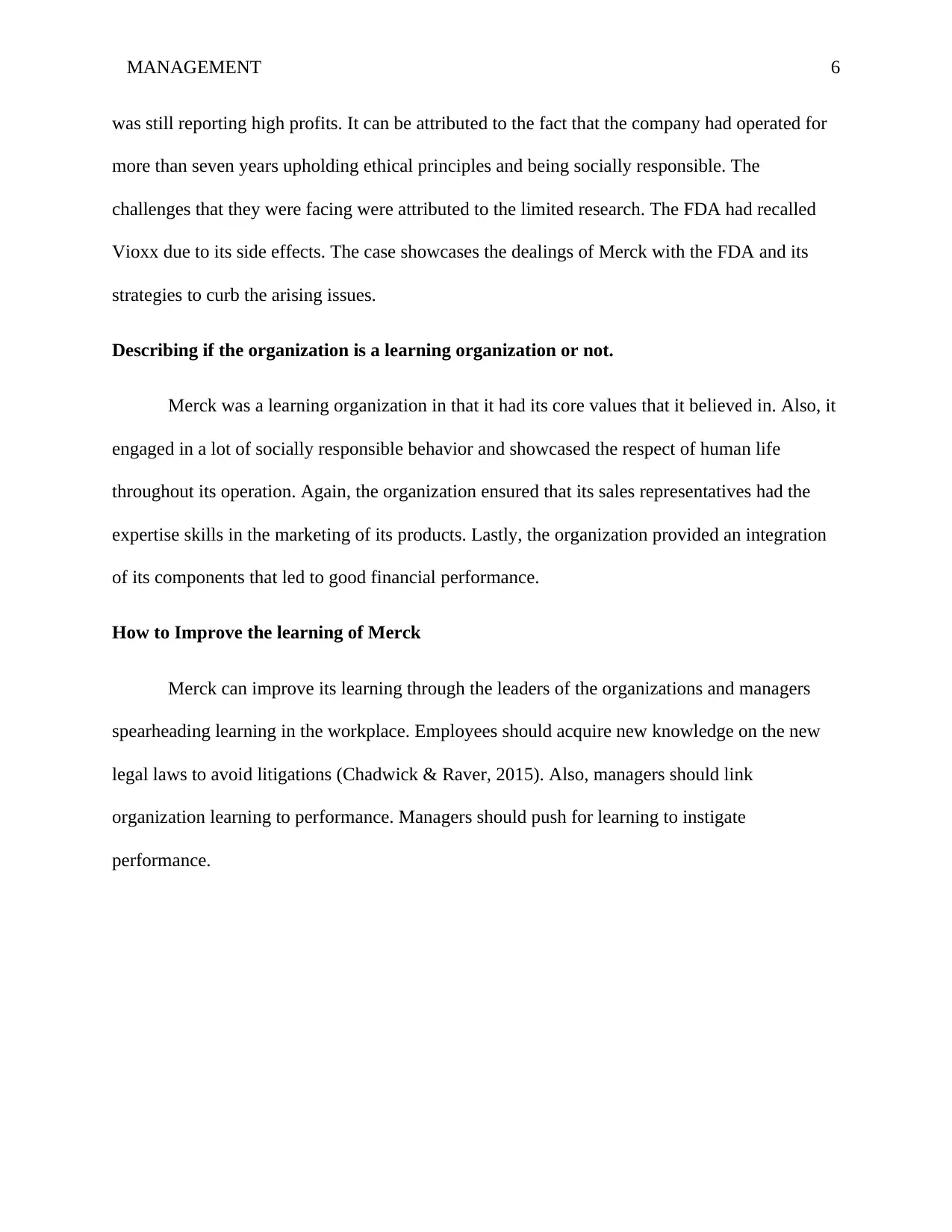
MANAGEMENT 6
was still reporting high profits. It can be attributed to the fact that the company had operated for
more than seven years upholding ethical principles and being socially responsible. The
challenges that they were facing were attributed to the limited research. The FDA had recalled
Vioxx due to its side effects. The case showcases the dealings of Merck with the FDA and its
strategies to curb the arising issues.
Describing if the organization is a learning organization or not.
Merck was a learning organization in that it had its core values that it believed in. Also, it
engaged in a lot of socially responsible behavior and showcased the respect of human life
throughout its operation. Again, the organization ensured that its sales representatives had the
expertise skills in the marketing of its products. Lastly, the organization provided an integration
of its components that led to good financial performance.
How to Improve the learning of Merck
Merck can improve its learning through the leaders of the organizations and managers
spearheading learning in the workplace. Employees should acquire new knowledge on the new
legal laws to avoid litigations (Chadwick & Raver, 2015). Also, managers should link
organization learning to performance. Managers should push for learning to instigate
performance.
was still reporting high profits. It can be attributed to the fact that the company had operated for
more than seven years upholding ethical principles and being socially responsible. The
challenges that they were facing were attributed to the limited research. The FDA had recalled
Vioxx due to its side effects. The case showcases the dealings of Merck with the FDA and its
strategies to curb the arising issues.
Describing if the organization is a learning organization or not.
Merck was a learning organization in that it had its core values that it believed in. Also, it
engaged in a lot of socially responsible behavior and showcased the respect of human life
throughout its operation. Again, the organization ensured that its sales representatives had the
expertise skills in the marketing of its products. Lastly, the organization provided an integration
of its components that led to good financial performance.
How to Improve the learning of Merck
Merck can improve its learning through the leaders of the organizations and managers
spearheading learning in the workplace. Employees should acquire new knowledge on the new
legal laws to avoid litigations (Chadwick & Raver, 2015). Also, managers should link
organization learning to performance. Managers should push for learning to instigate
performance.
⊘ This is a preview!⊘
Do you want full access?
Subscribe today to unlock all pages.

Trusted by 1+ million students worldwide
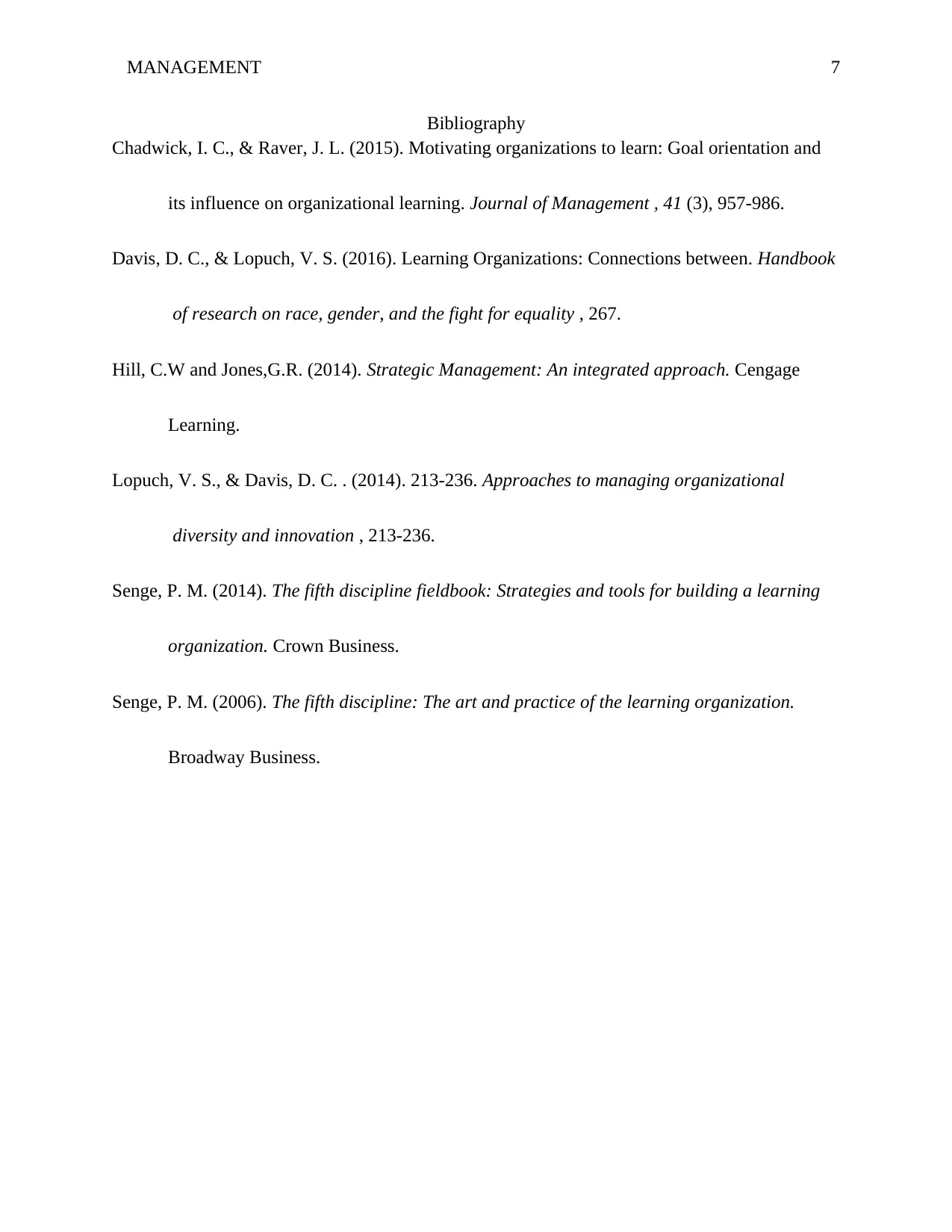
MANAGEMENT 7
Bibliography
Chadwick, I. C., & Raver, J. L. (2015). Motivating organizations to learn: Goal orientation and
its influence on organizational learning. Journal of Management , 41 (3), 957-986.
Davis, D. C., & Lopuch, V. S. (2016). Learning Organizations: Connections between. Handbook
of research on race, gender, and the fight for equality , 267.
Hill, C.W and Jones,G.R. (2014). Strategic Management: An integrated approach. Cengage
Learning.
Lopuch, V. S., & Davis, D. C. . (2014). 213-236. Approaches to managing organizational
diversity and innovation , 213-236.
Senge, P. M. (2014). The fifth discipline fieldbook: Strategies and tools for building a learning
organization. Crown Business.
Senge, P. M. (2006). The fifth discipline: The art and practice of the learning organization.
Broadway Business.
Bibliography
Chadwick, I. C., & Raver, J. L. (2015). Motivating organizations to learn: Goal orientation and
its influence on organizational learning. Journal of Management , 41 (3), 957-986.
Davis, D. C., & Lopuch, V. S. (2016). Learning Organizations: Connections between. Handbook
of research on race, gender, and the fight for equality , 267.
Hill, C.W and Jones,G.R. (2014). Strategic Management: An integrated approach. Cengage
Learning.
Lopuch, V. S., & Davis, D. C. . (2014). 213-236. Approaches to managing organizational
diversity and innovation , 213-236.
Senge, P. M. (2014). The fifth discipline fieldbook: Strategies and tools for building a learning
organization. Crown Business.
Senge, P. M. (2006). The fifth discipline: The art and practice of the learning organization.
Broadway Business.
1 out of 7
Related Documents
Your All-in-One AI-Powered Toolkit for Academic Success.
+13062052269
info@desklib.com
Available 24*7 on WhatsApp / Email
![[object Object]](/_next/static/media/star-bottom.7253800d.svg)
Unlock your academic potential
Copyright © 2020–2025 A2Z Services. All Rights Reserved. Developed and managed by ZUCOL.





